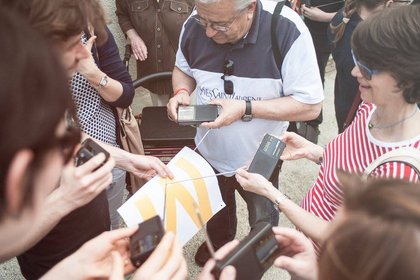
Museum of Housing Estates
Format Archive
City Lublin, Poland

The iconic late-modernist pavilion on Grażyny 7 originating from 1964, which used to house a famous local café and a cultural club called ‘high life for 2 euros’, is now in danger of demolition. It cannot find profitable functions or new hosts to revive it and maintain its economical demands. In response, the Lublin Days of Modernism Festival first delivered a prototype to turn it into a museum of its own, and by this intervention to open up the conversation about the district’s current pressing issues. The Museum of Housing Estates aims to deal with the discontent that a large part of the Polish population living in housing estates experiences. It turns controversial concrete heritage into individual myths and builds up a common yet agonistic identity. The idea was to create a collective monument, a patchwork memoir of the local housing estate inhabitants. As such, the past is actualized as a pretext for the present and near future of the buildings and their endangered complex heritage. Together with citizens we are still searching for other functions the museum could cover, to keep activating it as a non-commercial space for encounters, collaborations and integration of the local community.
Mobilization Call for action
Produce simple flyers [having big budget version – collage postcards of an estate ] asking inhabitants to deliver their stories and share personal souvenirs. We deliver flyers, posters to every building. As we operate in an area, where majority of residents are seniors, they prefer old school way of communication with a very simple and clear design. We use a snowball method, where one person gives contact to 5 neighbors, family or friends, who could be interested in co-creating Museum.
Location Gathering of the collection and researches
Conduct at least 30 interviews with residents, users, administrators –if possible – architects and visioners of the estate. While interviewing - collect at least 15 objects. Sometimes story comes from an item, sometimes we ask for object to share that would illustrate the story. When it’s difficult to get any, we ask for photos.
Additionally we make desk research in the housing structures archives, libraries, digital archives. While making decision on the topics, we follow our “donors of memory” to explore wider contexts, they’ve mentioned (or they intentionally wanted to keep silent about]. For example our interlocutors explained how they’ve created an environment for a new generation of urban citizens, coming to live in towns in the 60. and 70., still neglecting his rural provenience. We have found there interesting topic to dig in.
People Power Museum in the Dialogue. Participatory set (organizing) of an exhibition together with series of manual workshops
Time for creating curatorial descriptions and arranging thematic collections according to thematic paths. Museum purposely combines collections from several places at the same time to stimulate dialogue on specific phenomena, and in the case of high-level discussions, avoid stigmatizing specific sites.
Participatory planning of the collection is led in the process of workshops. Around already existing collections we weave the new plots with inhabitants interested to contribute in creative process.
Museum is being shaped of the minor components (puzzles), coming directly from citizens in the formal support of artists and curators. Co-authors of the Museum are the Residents and invited artists, who deliver workshop situations for forming individual subjective reflections threw art tools. E.G. “Family manual workshop for designing settlements with cardboard, including objects that no longer exist or are threatened with demolition” or “Workshops for exploring urbanism and local urban greenery and organizing a hint of it into a museum collection” .“Digital storytelling and remix of materials; sound installations, animations or giffs with tales of inhabitants “etc.
Communication Museum in Travel. Promoting the idea of Museum.
Travel of the scattered collection (themed by topic) starts with a trip to partner estates participating in the project. It’s being hosted in culture institutions and private dwellings. We talked to the owners of the flats involved in the ventures and usually expressed pride and emotion due to taking part in such a brave and wide-ranging initiative. The alternative will be spaces of publicly accessible service points and educational institutions. Possibly in other towns.
Each residence of the museum delivers new contexts and provokes it to be a tool discussing local challenges and hot topics.
Communication Communication and evaluation. Reflection and discussions
We try to interest local press to dedicate thematic insert and encourage experts derived from different professions; antropologists, urbanists, sociologists, historians, archivists, even developers to write articles about our Museum realization from their perspective.
- Lublin Modernism Days - where we have opened for one day museum prototype by Palce Liza? Collective, Paulina Paga and Izabela Pastuszko
- Our 1.st inspiration was Common Museum of Kalinowszczyzna District made under auspices of Workshops of Culture in Lublin by Szymon Pietrasiewicz and Pawe? Laufer
- X Apartments - one of situations from Polish art-world that we take inspirations from


LSM estates continously provokes discussions between architects and art historians. Some of them seem to forget that the housing estate is not just an architecture or an urban plan. The dozen of interesting forms of blocks are inhabited by several thousands of (no less interesting!) people. In our opinion, residents are the true practitioners of the Open Form theory in housing, and our task is to strengthen their perspectives.











